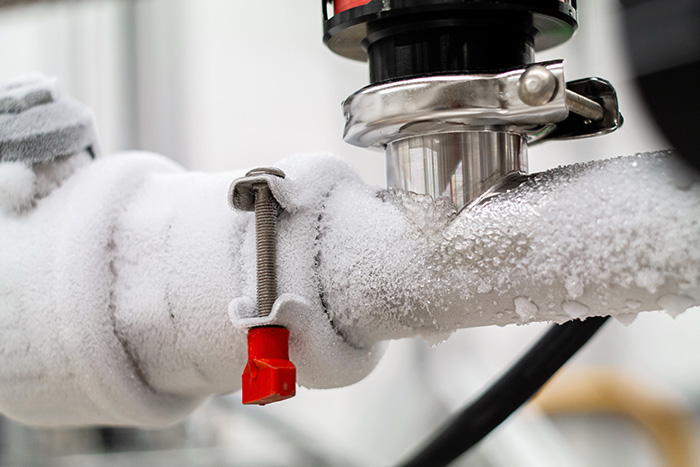Each person maintains their private perception with regards to Helpful Tips to Prevent Frozen Pipes this Winter.

Cold weather can damage your pipes, specifically by freezing pipes. Below's how to stop it from happening and what to do if it does.
Intro
As temperature levels drop, the danger of frozen pipes increases, possibly leading to pricey fixings and water damages. Recognizing exactly how to avoid frozen pipelines is essential for house owners in chilly climates.
Avoidance Tips
Protecting susceptible pipes
Cover pipes in insulation sleeves or utilize heat tape to shield them from freezing temperatures. Focus on pipelines in unheated or outside areas of the home.
Heating methods
Maintain indoor spaces sufficiently heated up, specifically areas with plumbing. Open cupboard doors to enable warm air to distribute around pipelines under sinks.
Exactly how to recognize frozen pipes
Try to find reduced water flow from faucets, unusual smells or sounds from pipelines, and noticeable frost on subjected pipelines.
Long-Term Solutions
Structural changes
Take into consideration rerouting pipelines far from exterior walls or unheated locations. Add extra insulation to attics, cellars, and crawl spaces.
Updating insulation
Purchase premium insulation for pipes, attic rooms, and wall surfaces. Proper insulation assists maintain consistent temperatures and decreases the threat of frozen pipes.
Securing Exterior Plumbing
Yard hose pipes and outdoor faucets
Separate and drain pipes yard pipes before winter. Mount frost-proof spigots or cover exterior taps with shielded caps.
Understanding Frozen Pipes
What causes pipelines to ice up?
Pipes ice up when subjected to temperatures listed below 32 ° F (0 ° C) for expanded durations. As water inside the pipelines freezes, it expands, taxing the pipe wall surfaces and possibly causing them to burst.
Risks and damages
Icy pipelines can cause water system interruptions, residential property damage, and pricey repair services. Ruptured pipes can flood homes and cause extensive architectural damages.
Indicators of Frozen Water Lines
Determining frozen pipelines early can stop them from rupturing.
What to Do If Your Pipes Freeze
Immediate actions to take
If you suspect icy pipelines, keep faucets open up to relieve pressure as the ice thaws. Make use of a hairdryer or towels taken in hot water to thaw pipes gradually.
Final thought
Avoiding frozen pipelines requires positive actions and quick reactions. By understanding the reasons, indications, and safety nets, home owners can safeguard their plumbing throughout winter.
5 Ways to Prevent Frozen Pipes
Drain Outdoor Faucets and Disconnect Hoses
First, close the shut-off valve that controls the flow of water in the pipe to your outdoor faucet. Then, head outside to disconnect and drain your hose and open the outdoor faucet to allow the water to completely drain out of the line. Turn off the faucet when done. Finally, head back to the shut-off valve and drain the remaining water inside the pipe into a bucket or container. Additionally, if you have a home irrigation system, you should consider hiring an expert to clear the system of water each year.
Insulate Pipes
One of the best and most cost-effective methods for preventing frozen water pipes is to wrap your pipes with insulation. This is especially important for areas in your home that aren’t exposed to heat, such as an attic. We suggest using foam sleeves, which can typically be found at your local hardware store.
Keep Heat Running at 65
Your pipes are located inside your walls, and the temperature there is much colder than the rest of the house. To prevent your pipes from freezing, The Insurance Information Institute suggests that you keep your home heated to at least 65 degrees, even when traveling. You may want to invest in smart devices that can keep an eye on the temperature in your home while you’re away.
Leave Water Dripping
Moving water — even a small trickle — can prevent ice from forming inside your pipes. When freezing temps are imminent, start a drip of water from all faucets that serve exposed pipes. Leaving a few faucets running will also help relieve pressure inside the pipes and help prevent a rupture if the water inside freezes.
Open Cupboard Doors
Warm your kitchen and bathroom pipes by opening cupboards and vanities. You should also leave your interior doors ajar to help warm air circulate evenly throughout your home.

We were made aware of that report on Winter Plumbing Precautions: Preventing Frozen Pipes from an acquaintance on our other web page. You should take a moment to promote this page if you enjoyed reading it. Thanks a lot for going through it.
Contact Us Now